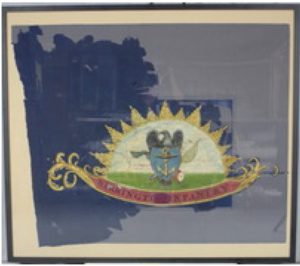Militias, the Barrington Militia, and Their Flag
Today, the term “militia” is loosely applied to many armed groups, official and unofficial, legal and extralegal. Sometimes they even act in opposition to the established government and the military. At the time of the Dorr Rebellion, however, “militia” referred to a military unit, drawn from the civilian population, authorized, organized, and subsidized by the local and state governments. It was intended to supplement regular, full-time military forces, and to help suppress rebellion or repel invasion.
Before the United States became independent, the English colonies had their own militias. The colony of Massachusetts organized the first one on December 13, 1636. After independence, each state had its own militia, with its own rules and regulations. To standardize training and procedures, Congress passed the Efficiency in Militia Act of 1903, which gave ultimate authority over state militias to the federal government. The National Defense Act of 1916 mandated the term “National Guard” for state militias and introduced other regulations.
Before the 20th century, although the colony (and then the state) was responsible for calling out the militia, towns generally organized and trained their own militias. Barrington’s was trained on what is now the front lawn of Town Hall, and the town sent militia to what became known as the Battle of Bunker Hill in June 1775, at the beginning of the Revolutionary War. During that war almost all able-bodied Barrington men between the ages of 16 and 60 served in the Barrington Militia.
Flags like this symbolically represented their towns, and during combat they often served as important, visible rallying points during the confusion and chaos of battle. However, because Barrington’s flag signaled support for Governor King and opposition to Dorr’s campaign, it was also a divisive symbol. As we have seen, the absence of an equivalent banner for the Dorrites should not lead us to conclude that the town was united against Dorr.
Thanks to generous support from the Heritage Harbor Foundation, the Barrington Militia flag has been restored (see below). The restored flag is now on display in the Barrington Preservation Society’s Museum in the Peck Center/Library lower level. Designed and produced during the 1920s, it was most famously deployed during the Dorr Rebellion of 1842.

As noted by East Bay Newspapers (March 16, 2019): “The flag is hand-painted on blue silk and signed by William W. Pitman, who was a professional sign and flag painter in Providence from 1824 until his death in 1838. The flag bears the name of Barrington’s militia company, along with Federal and state heraldic symbols, and was used to drill the town’s militia company.”
The legend “Barrington Infantry” appears on the front, and “4th Company 4th Reg.” [i.e., “Regiment, which identifies it as part of Rhode Island’s militia system] appears on the back. The 4th Regiment was drawn from towns in the East Bay…In the center of the front of the flag is the Rhode Island coat of arms with the American eagle, military symbols (guns, drums, and cannonballs), and the original state motto, “In God We Hope.” (The state’s current motto is simply “Hope.”) The same eagle, in a different pose, is on the back.
